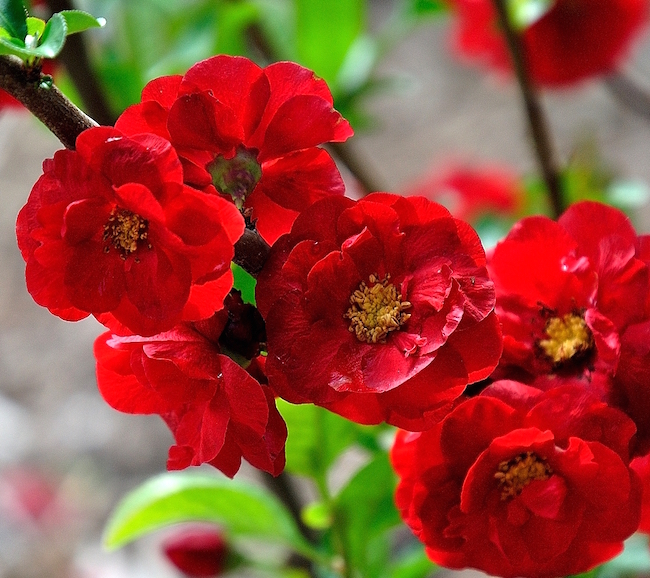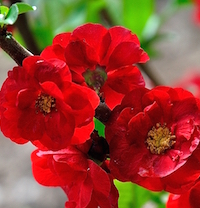There has been a storm brewing in North Carolina and it is one that will prove to beautify our landscapes across the country. The Mountain Horticultural Crops Research and Extension Center team in Mills River, North Carolina, already horticultural heroes of sorts with their incredible, white-flowered ‘Sweet Tea’ Mountain Gordlinia, are now bringing to the landscape the Double Take Storm flowering quinces with the most shocking blooms you ever imagined.
The three selections are ‘Scarlet Storm,’ ‘Pink Storm’ and ‘Orange Storm.’ They are all double flowered and will cause you to first think of a camellia. With a group of three that now fall under a series called Double Take, you will most likely find Double Take ‘Scarlet Storm.’
Botanically speaking, they are all selections of Chaenomeles speciosa, which is native to China. It is the breeding program at North Carolina State University, however, that is bringing us these shrubs that will reach approximately 6 feet tall and 4 feet wide at maturity, boasting dazzling double flowers with huge petal counts.
The old-fashioned flowering quince always seems to be bare of flowers on the tips or tops of the plant, but these blooms that reach up to 2.5 inches in diameter stretch outward to the tip of the stem. That means the blossoms are almost as large as a tennis ball. Here at the Coastal Georgia Botanical Gardens at the Historic Bamboo Farm in Savannah, Georgia, they have been sensational. They are cold hardy from zones 5 through 9 and are deer resistant.
When you get yours, select a site in full to partial sun. These great flowering quinces deserve to be planted in a well-prepared shrub bed. Incorporate 3 to 4 inches of organic matter along with about 2 pounds of a 5-10-5 fertilizer per 100 square feet of planting area. Till your soil deeply and dig your hole about three times as wide as the rootball, but no deeper. Place the flowering quince in the hole and backfill to two-thirds. Tamp the soil and water to settle. Add the remaining backfill and repeat the process, getting all of the air pockets out and providing a great start for acclimatization of your new shrub.
These plants bloom on old wood, so remember not to get pruning-happy when they are in their deciduous or dormant state of winter. If any pruning is needed, make these cuts after the spring bloom. Of course, these make breathtaking cut flowers, so select as needed.
These blooms sequence nicely with spring-blooming bulbs like Dutch iris, daffodils and the iridescent blue of the Peruvian lily, Scilla peruviana, which is cold hardy to around zero degrees Fahrenheit. Try clustering three in front of evergreen hollies. I notice that our Chinese snowball viburnums and ‘Scarlet Storm’ are blooming. They are, however, in different parts of the garden.
To me, the flowering quince has always been that harbinger of spring. It’s the one plant that shouts with its colorful blooms, “You have survived winter!” Even though I loved those old blooms, they pale in comparison to a plant like ‘Scarlet Storm.’ Spring is early in the South, so gardeners here may want to start shopping. Elsewhere in the country, you can procrastinate a little, or better yet, go ahead and let your favorite nurseryman know you are coming soon to pick up three.
Follow me on Twitter @CGBGgardenguru.








